Join us for a webinar on Oct 10 to learn how Bidgely is "Empowering Utilities with GenAI:
A Guide to Enhanced CX and Grid Management". Register here.
Technology leaders across the utility industry recognize the limitations that data silos and disparate information create within the organization. With this in mind, many utilities have invested heavily in next-generation cloud data platforms, like Snowflake, to centralize AMI, CIS, GIS, and other data streams to establish a consistent data foundation across operational areas. When paired with the power of generative AI, these investments can accelerate cross-functional collaboration and improve efficiencies.
These foundational data investments are essential steps forward. However, unlocking their full potential requires deep domain expertise and specialized customer intelligence that enables business units to deliver personalized customer experiences, ensure affordability, and power a reliable grid.
That’s why we’re excited to announce that Bidgely is a launch partner for Snowflake Intelligence. This partnership will connect Bidgely’s UtilityAI Pro models and MCP servers to Snowflake Intelligence, enabling utility-specific use cases and AI agent development while running securely in the utility’s own cloud environment.
UtilityAI Pro™ packages Bidgely’s patented machine learning models – backed by billions of data points and over a decade of data science research and development – and securely deploys them directly in the utility’s cloud environment, such as Snowflake. Without requiring any external data transfer, utilities gain access to a foundational layer that enables utility-specific AI agents, integrations with existing utility tools, and development of custom applications.
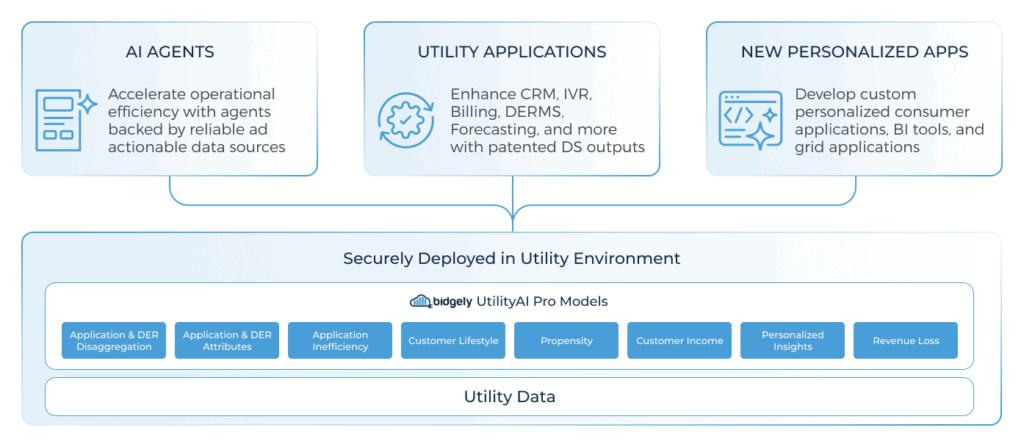
Bidgely UtilityAI Pro™
Snowflake Intelligence enables conversational AI with structured and unstructured data sources from across utility and third-party data sources. With Snowflake Intelligence, utilities can interact with data in natural language and intuitively build data agents, while leveraging any leading gen AI model.
Combining governed data in Snowflake with utility-specific intelligence from Bidgely’s UtilityAI Pro™ enables AI agents to answer questions specific to the utility industry, such as:
In the example below, a DSM Program Manager agent, designed with the specific goal of designing cost-effective programs, helps a utility team member identify the highest value customers to target for enrollment in a new program.
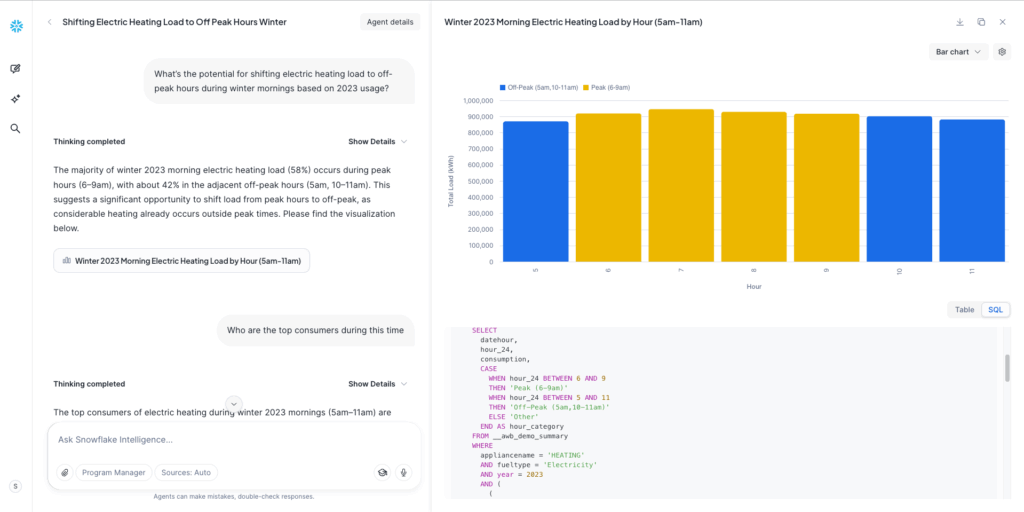
DSM Program Manager Agent in Snowflake Intelligence
These agents allow utility teams to accelerate project development, unlock operational efficiencies, and focus on more strategic avenues for serving their customers
Find out how to unlock ROI, reliability, and resilience across your utility. Contact the Bidgely team for an overview and demo of the solution.
Extreme volatility in the energy wholesale price is keeping European energy retail executives worried!
The scale of the challenge is unmistakable. According to the International Energy Agency (IEA), energy markets in Europe have had a volatile start to 2025, with prices surging to their highest level in two years.
Wild price swings create chaos for energy retailers, and when wholesale costs spike unexpectedly, suppliers face difficult choices about how to respond: When wholesale prices spike unexpectedly, suppliers must decide whether to absorb the costs or pass increases through to customers. Both options are problematic. Absorbing costs hurts the business, whilst price increases drive customer churn.
The challenge is compounded by customer expectations. Most energy customers have little tolerance for sudden bill increases, putting retailers in a difficult position when wholesale costs surge.
However, forward-thinking energy retailers are leveraging a powerful tool available today to provide a hedge against wholesale chaos: customer-side demand flexibility.
The solution to the market volatility challenge lies in transforming customers from passive energy consumers into active flexibility partners.
According to Eurelectric, consumption flexibility can be defined as “temporarily increasing or reducing electricity consumption based on grid conditions and market signals.” This flexibility requires more than smart thermostats and off-peak electric vehicle charging, though both play an important role. True demand flexibility requires building systematic capabilities to holistically influence customer consumption patterns in response to wholesale market conditions.


When wholesale prices rise, retailers with effective demand flexibility programmes can reduce their customers’ aggregate consumption, lowering their exposure to high-cost energy purchases. When wholesale prices drop, they can encourage increased consumption to take advantage of low-cost periods.
Retailers with effective TOU tariffs, managed charging or other demand flexibility programmes are able to reduce their customers’ aggregate consumption when dealing with predictable variations, such as peak vs. off-peak periods, during which price changes are expected.
Further, in the case of unpredictable volatility, in which wholesale prices suddenly spike or plummet due to unforeseen events, responsive demand flexibility becomes even more critical.
The goal in both scenarios is to create a natural hedge against volatility whilst providing value to customers through reduced bills.
Successfully implementing demand flexibility requires moving beyond ad hoc appeals for conservation during crisis periods. Instead, retailers need systematic capabilities to influence customer behaviour both proactively and responsively.
Proactive Demand Management
Time-of-Use tariffs represent the foundation of proactive demand flexibility. However, effective Time-of-Use programmes require sophisticated customer engagement to help consumers make energy choices that maximise savings and load shift.
Electric vehicle managed charging programmes offer another powerful tool for proactive demand management.
Responsive Demand Flexibility
Responsive demand flexibility involves real-time adjustments to consumption based on immediate market conditions. When wholesale prices spike unexpectedly, retailers with responsive capabilities can quickly reduce customer demand through targeted communications, smart device controls or demand response incentives.
Achieving responsive demand flexibility requires sophisticated communication capabilities and customer segmentation by appliance ownership, contribution to peak load, time-of-day usage patterns, and historic responsiveness. Different customers respond to different types of appeals, such as cost savings messages, environmental benefits, and convenience features. Effective responsive demand management delivers the right message with the right incentive to the right customer at the right time.


Demand flexibility programmes succeed or fail based on customer participation, which is directly proportional to customers’ level of engagement with their retailer. Getting customers to actively manage their energy use requires reimagining customer experience around 4 core principles:
1) Hyper-Personalised, Appliance-Specific Engagement
Generic energy-saving messages don’t drive any meaningful engagement nor any behaviour change. Customers need accurate, relevant insights delivered through their preferred channels. If energy use and cost insights aren’t trustworthy or personally relevant, customers won’t engage, and their relationship with the retailer will remain transactional.
This means moving beyond mass communications to personalised engagement based on individual energy use habits, appliance ownership and demonstrated preferences. For example, a customer with supplemental electric heating needs different messages than one with a heat pump, and a household with solar panels will respond to different incentives than one without. AI-powered behind-the-meter data analysis can identify which customers have the greatest flexibility potential based on their unique energy profiles.
Effective demand flexibility programmes connect behavioural calls-to-action to optimal timing. For example, if a customer is trending toward a high bill, it’s an ideal moment to encourage conservation and promote Time-of-Use tariffs or managed charging programmes.
This requires sophisticated analytics to identify the right moments for engagement. Successful programmes don’t wait for monthly bills to arrive. They provide real-time insights and recommendations that help customers make better decisions in the moment.
3) Trust Through Transparency
Customers participate in demand flexibility programmes when they trust their energy supplier and understand the benefits. This requires transparent communication about how programmes work, what customers can expect to save and how their participation contributes to overall system reliability.
Building this trust takes time and a proven track record for delivering on promises. Retailers who over-promise savings or fail to deliver on programme commitments quickly lose customer confidence, engagement and participation.
4) Continuous Improvement
Real-time analytics allow retailers to continuously measure and optimise demand flexibility performance among the customer target group. Understanding which messages drive behaviour change, which customers participate most actively and which programmes deliver the greatest wholesale cost savings enables continuous improvement and expansion.
Energy retailers who build systematic demand flexibility capabilities will enjoy significant advantages in the midst of volatile wholesale markets. Lower exposure to price spikes translates directly to improved financial performance. Plus, stronger customer relationships built through valuable energy management services reduce churn.
Perhaps most importantly, demand flexibility capabilities create differentiation that extends beyond price competition. Customers who actively participate in their supplier’s flexibility programmes develop sticky relationships that are difficult for competitors to replicate.


Wholesale market volatility isn’t going away. Climate change, geopolitical tensions and the energy transition ensure that European energy markets will remain challenging for the foreseeable future. Rather than remaining vulnerable to these market forces, energy retailers can build capabilities that transform this volatility into competitive advantage.
The suppliers who will thrive in volatile markets are those who stop viewing customers as passive consumers and start empowering them as active flexibility partners. Customers continue to demonstrate their appetite and appreciation for energy management tools. Empowering them with the insights to take action strengthens customer relationships and reduces wholesale exposure through sophisticated demand flexibility programmes.
In fact, it’s possible to turn volatility into an asset with Bidgely:
To learn more about how Bidgely turns market volatility into opportunity and see how AI-powered demand flexibility works in practice, explore Bidgely’s personalised customer engagement and demand flexibility solutions in our demo portal or contact us for a chat.
The European energy retail market is trapped in a vicious cycle. Customers switch providers to gain the smallest cost savings, suppliers slash margins to compete, and genuine differentiation becomes nearly impossible. This commoditisation crisis threatens to trap the entire sector in an unsustainable race to the bottom.
But recent customer research suggests there’s a better path — one that isn’t driven by price alone.
The numbers tell a stark story. In 2024, Eurelectric and Accenture surveyed more than 2,000 energy consumers and 60+ suppliers across 12 European countries. Nearly one in three consumers reported having switched energy suppliers in the past two years — primarily to save money. This represents an eight percentage point increase since 2021, and the trend continues to accelerate.
Looking ahead, one in four consumers plan to switch providers within the next year to save on their energy bills. For energy retailers, this creates a punishing economic reality where customer acquisition costs continue rising whilst customer lifetime value diminishes.
Here’s what’s encouraging: the same Eurelectric study reveals that consumers also increasingly appreciate more than low-cost energy. Nearly half of surveyed consumers are also aware of their energy supplier’s offerings to help manage energy bills, and 28% report feeling more positively in control of their energy usage, thanks in large part to tips and advice from their suppliers.
This data points to a fundamental shift in consumer expectations. Today’s energy customers don’t just want to pay less; they want to understand their consumption, make smarter decisions, and gain genuine control over their energy costs.
The solution? Deliver service that transforms you from a commodity energy provider into a valuable, trusted energy advisor in the eyes of your customers.
Successfully making this transition requires moving far beyond generic energy-saving tips that are often off the mark. True differentiation comes from providing insights and recommendations based on each customer’s specific appliance ownership, consumption patterns and unique household energy profile.
This level of personalisation addresses what Eurelectric identifies as a key market challenge: “Smart energy technologies offer strong potential to help consumers manage costs, yet adoption is limited by lack of interest, awareness, and perceived relevance.”
The key word here is “relevance.” Customers need advice that speaks directly to their unique circumstances.
Two AI capabilities are revolutionising how energy suppliers can deliver personalised advisory services:
Meter Data Disaggregation
AI-powered true disaggregation of smart meter data is able to identify the energy consumption signatures of individual appliances within a given household. This provides consumers and customer service agents with unprecedented visibility into behind-the-meter energy use, across every hour of the day. Instead of receiving a total monthly bill, customers are able to see exactly which appliances and energy habits are primarily responsible for their costs.
Generative AI Interfaces
Natural language AI makes these complex insights accessible to everyday consumers. A customer can simply ask, “Why did my cooling costs increase compared to last year?” and receive a personalised explanation along with specific recommendations for reducing future costs. This conversational approach to energy data democratises access to sophisticated insights whilst reducing the cost-to-serve associated with contacting the call center for the same insights.
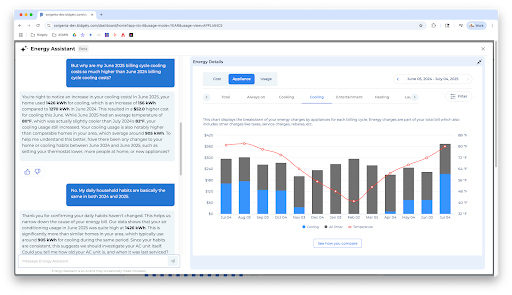
When energy suppliers provide genuine value through personalised insights and advice, it improves customer retention. Customers who rely on their supplier’s energy management tools and advice are less likely to switch to obtain marginal savings. The relationship becomes stickier when it is based upon a value proposition of ongoing service and support, not just commodity provision, breaking the cycle of price-only-based decision making.
Energy suppliers who embrace the hyper-personalised, energy advisor model now will enjoy significant competitive advantages: lower customer acquisition costs, reduced churn, sustainable margins, and stronger customer relationships.
The European energy retail sector stands at a crossroads. Suppliers can continue down the path of commoditisation and margin erosion, or they can seize the opportunity to redefine their role in customers’ lives. The choice, and the competitive advantage, belongs to those who act first.
To see what personalised AI-powered customer engagement looks like in action, check out our demo portal and read our case study about how Electric Ireland has maximised the value of data to deliver a superior energy customer experience.
Small-scale energy generation and storage distributed energy resources such as solar PV, wind turbines, batteries and EVs (batteries on wheels) have little grid impact individually. But with scale their grid impact surges.
Millions of consumers have already adopted solar, batteries and/or electric vehicles. More importantly, thanks to cost reductions, product improvements and a desire for greater resiliency, the number of DERs is expected to reach tens of millions by the end of the decade with ~1 TWh of capacity to generate, consume and store energy.
This capacity surge offers tremendous potential benefits. DERs can stabilize the grid through virtual power plants and help utilities generate more revenue through electrification than they spend on energy generation and distribution.
However, rapid DER growth also presents serious challenges. With so many DERs operating independently, demand-supply imbalances at the local level will become a reality playing havoc on the grid and with electricity rates.
The solution lies in AI-powered grid planning and management, which makes it possible to harness DERs’ positive potential while mitigating risks across all categories.
The primary EV challenge utilities face is peak demand contribution. When drivers return home from work and plug in their 8-12 kilowatt chargers, the demand on the grid multiplies exponentially.
Compounding this challenge, EV adoption doesn’t occur uniformly across territories. Instead, it happens in pockets with dramatic variation from zip code to zip code, even block to block. This uneven pattern creates congestion hotspots at the distribution level, overloading some transformers and substations while leaving others underutilized.
Smart Targeting Strategies
Traditional non-targeted managed charging programs suffer from low enrollment because of their invasive nature. Moreover, customers who enroll may not be the biggest contributors to grid stress, leading to low return on investment.
The answer lies in precision targeting. A blend of behavioral and direct managed charging initiatives that target peak users in areas where the grid operates near maximum capacity engages the broadest range of EV drivers while dramatically amplifying infrastructure benefits.
AI-driven behind-the-meter EV intelligence enables utilities to identify owners most likely to alleviate load at congested grid assets. This intelligence helps utilities target incentives effectively and engage drivers in the full spectrum of programs—behavioral managed charging, EV time-of-use rates, and direct managed charging.
By building trust and improving customer relationships, utilities increase the likelihood that drivers will grant some control over their charging activities. More effective customer-program alignment can reduce the cost per kilowatt and nearly double EV hosting capacity on the distribution grid.
With solar systems, utilities must flatten the “duck curve” — the phenomenon where solar produces peak energy midday when demand is lower, then stops producing during evening peak demand after sunset.
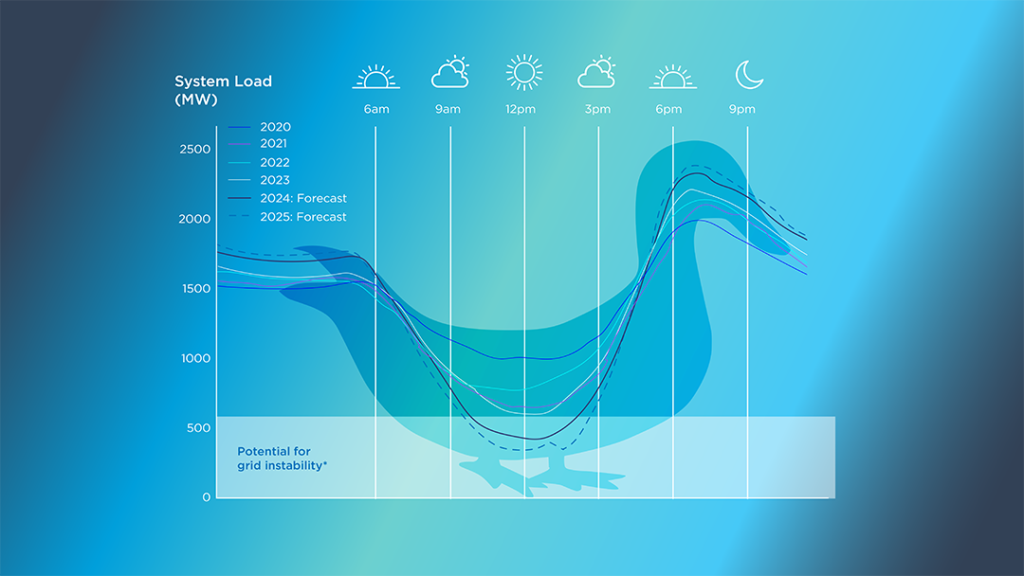
Flattening the curve means tapping into the energy stored in these distributed resources. This begins with identifying residential customers with rooftop solar, including array size and daily and seasonal generation patterns. Advanced disaggregation technology can detect how household net generation flows into the grid.
Storage as the Solution
As with EV programs, targeted participation from solar customers based on geography and generation capacity is essential. Pairing solar with batteries that store daytime energy provides utilities with access to distributed, reliable power during peak demand.
Utilities need energy storage assets where the grid faces the greatest strain and requires load shaping or resiliency support. Current storage deployment patterns may not align with grid demand, making data-driven program targeting crucial.
Behind-the-meter disaggregation helps utilities incentivize customer adoption in areas where residential storage provides maximum benefit while gaining control of these assets. Virtual power plant programs demonstrate the effectiveness of combining customer-supplied batteries with dynamic incentives and device control mechanisms.
Accelerating DER adoption appears inevitable. In some regions, solar and EV adoption already exceeds 30 percent. Without proper management, DERs risk creating significant costs for customers and energy providers alike. With effective management, they promise improved grid stability, equity, and utility revenue without increasing overall costs.
Success across all DER types requires six critical best practices:
Through advanced disaggregation technology, utilities can understand energy demand and supply at the household level, enabling purpose-built strategies for each DER type.
Learn more about Bidgely’s AI-powered solutions to help you manage DERs and see our DER Grid Planning solution in action in our demo portal.
In today’s rapidly evolving energy landscape, utilities face unprecedented challenges with increasing DERs, electrification and changing customer behaviors. In response, forward-thinking energy providers are increasingly turning to Non-Wires Alternatives (NWAs) as compelling solutions that go beyond traditional infrastructure investments.
“Historically, we have looked closely at how our traditional wires solutions have helped our customers to maintain reliability,” explains Dhaval Patel, Senior Network Manager at Hydro One. “But because of the changing nature of the electrification load and customer behavior, we have started looking for non-wires solution alternatives, and data is a big help in identifying the best use cases for NWAs.”
This shift in approach isn’t just about managing current challenges — it’s about positioning utilities for future success. Over the next decade, utilities that effectively leverage NWAs and data-driven capital investment strategies will enjoy significant advantages: stronger ROI, reduced operational costs and more resilient business structures.
1. Enhanced Forecasting Capabilities
The foundation of effective grid management starts with accurate forecasting. By developing a behind-the-meter understanding of appliance ownership and usage patterns, utilities can create comprehensive territory-wide load profiles with unprecedented detail.
By combining these detailed load profiles with broader housing and appliance ownership trends, utilities are able to forecast peak load 5-15 years into the future with reliable accuracy. This granular approach also facilitates scenario analysis for various electrification pathways — revealing exactly how and when heat pumps, EVs and other DERs will impact the grid.
Patel confirms that Hydro One is pursuing just such a strategy: “We have been collecting a lot more customer data,” Patel explains. “However, primary monitoring and data collection points were at the feeder or station levels, but we never looked behind the meters. Now, by analyzing behind-the-meter customer behaviors, we try to sense how many electrical vehicles customers are adopting.”
2. Targeted Non-Wires Alternatives Programs
With AI-powered analytics, utilities can examine load curves across their grid assets to identify maximum, minimum, and average demand patterns. This precision reveals exactly which substations are approaching capacity constraints and which specific appliances are driving peak demand.
Armed with this intelligence, utilities can design highly effective NWA programs that:
“Now we are looking more at customer behaviors and customer engagement,” Patel notes. “Looking at the behind-the-meter behaviors helps us understand how it integrates into the load profile, how it impacts our stations, and how we can better manage our stations and load profiles at a micro level.”
Consider the practical application: By analyzing household consumption patterns, utilities can identify customers who charge electric vehicles or run pool pumps during peak hours and target them specifically for load shifting programs — creating immediate benefits for both the customer and the grid.


3. Optimized Infrastructure Investment
While NWAs offer powerful alternatives to traditional infrastructure, strategic grid investments remain essential. The challenge is knowing exactly where and when to deploy capital for maximum impact.
“We are trying to understand the heating electrification impact on our grid as heat pumps are becoming really popular in Ontario. This data helps us to accurately forecast load, which helps identify the future grid investments we’ll need to make and the constrained areas that we need to alleviate.”
Using a comprehensive data approach, utilities are able to:
The benefits extend beyond traditional grid assets. With insights into current and future EV adoption patterns, utilities can strategically place public charging infrastructure in locations that will deliver the greatest value.
The energy landscape is transforming rapidly, driven by electrification, customer behavior shifts, and climate imperatives. Utilities that embrace data-driven approaches to grid management will be best positioned to navigate these changes successfully.
By developing comprehensive visibility into both grid-level and behind-the-meter dynamics, energy providers can balance reliability with cost-effectiveness through a strategic mix of NWAs and targeted infrastructure investments.
As Patel emphasizes, “Data serves as a basic foundation.” That foundation enables utilities to build a more resilient, flexible, and customer-centered grid that will meet the challenges of today while preparing for the demands of tomorrow.
The future of energy is already here—and it’s being shaped by those who understand that in an increasingly complex grid environment, data-driven decision making is the key to success.
For more information about Bidgely’s DER grid planning capabilities, download this guide to Bottom-Up Grid Planning Through Behind-the-Meter DER Intelligence.
As electric vehicles (EVs) reach mainstream customers, utilities are facing challenges in serving demand growth from EV charging, particularly on the distribution level. According to recent projections, EV adoption is expected to grow from 4.8 million EVs on U.S. roads today to 78.5 million by 2035 — representing more than 26% of all cars and light trucks. While recent market shifts due to tariffs and potential changes to EV tax credits may affect this projection, utilities are already experiencing substantial impacts directly attributed to EVs, which means that identifying and understanding EV-driving customers has never been more important for utilities to mitigate grid constraints.
In fact, unmanaged EV load has the potential to require billions* of dollars in secondary transformer and service upgrades, all while supply chain constraints on transformers complicate infrastructure expansion. At the same time, additional pressures from building electrification and other load growth are compounding the challenge.
Being proactive is key to reduce or delay the need for such investments, including EV time-of-use rates, active managed charging programs, and other load shifting and shaping interventions. In addition, when machine-learning (ML) and artificial intelligence are applied to AMI data to reveal territory-wide insights, project managers are able to develop strategies to use EVs for load flexibility and virtual power plants (VPPs). AI also empowers utilities to identify areas where EVs are contributing to non-peak time congestion on the distribution grid.
“The rapid growth in EV adoption creates both challenges and opportunities for utilities,” says Brittany Blair, Manager, Research & Industry at the Smart Electric Power Alliance (SEPA) and one of the authors of SEPA’s recent Insight Brief: AI for Transportation Electrification. “Without proactive management, grid impacts from unmanaged charging could be costly, but with the right data-driven approach, utilities can turn EV charging into a grid asset. And the time to prepare for that future is now.”
*California Public Advocates Office (2023); Kevala (2023); NYSERDA (2022)


U.S. electric utilities have already begun preparing for transportation electrification. As of 2022, 59% of electric utilities in SEPA’s network had established strategic plans for managing this new load, and a key part of those plans is increasing situational awareness of the grid edge and creating data-driven approaches to managing EV charging. What has changed more
recently, is the ability of artificial intelligence (AI) and machine learning to capitalize on existing data flows from the grid and provide the insights needed to enhance utility strategies. At its core, the benefit of using AI for EV detection is precisely that: more sophisticated, data-driven situational awareness.
Artificial intelligence and machine learning provide utilities with an advanced understanding of EV impacts and allow them to better plan for EV demand growth. Using AI, forward-thinking utilities are accelerating their efforts to identify EV-driving customers, create targeted marketing and EV engagement programs, and account for EV charging within their broader distribution system management strategies.
According to SEPA’s research, effectively managing transportation electrification is made easier with a four-step, AI-enabled process:
For transportation electrification specifically, AI solutions that detect EVs from premise-level meter data give utilities visibility into charging behaviors without requiring additional hardware investments. Traditional methods of gathering EV ownership information like vehicle registration records, telematics and customer surveys can leave a data gap that limits utilities’ ability to plan distribution systems efficiently and implement effective EV load management programs. AI can reveal what traditional methods miss.
The Insight Brief: AI for Transportation Electrification features two case stories from utilities who are leading the way when it comes to AI-informed EV strategies: Hydro One in Ontario, Canada, and NV Energy in the state of Nevada.
With EV adoption growing, particularly in areas already facing load growth from new construction, Hydro One was seeking better ways to identify EV drivers beyond customer surveys. By implementing Bidgely’s AI-powered analytics, Hydro One was able to identify 20,000 customers with EV charging activity — approximately 10 times more than they had identified via customer surveys. The utility also realized what it calls its “highest click through rate” in recent history via targeted email recruitment campaigns and is able to create territory-specific EV load shapes to inform grid planning.
NV Energy turned to AI to better understand customer preferences and charging trends while identifying and testing technology that could help improve distribution and resource planning processes to prepare for future grid constraints from additional EV load. Using Bidgely’s patented AI, NV Energy was able to detect 50 customers with high-value baseline charging behavior and achieve a load-shift potential of 2-4 kW/vehicle per event – far above the typical 0.2-0.8 kW/vehicle. The utility’s learnings helped inform its 2025-2027 Transportation Electrification Plan.
As utilities advance their distribution system planning capabilities for the future grid, improved EV insights can inform a cascade of other investments. Utilities can deploy AI’s capabilities in classification, assessment, automation, prediction, and customer engagement benefitting their teams at every stage from strategic planning to system investments to operations.
“Utilities that invest in managed charging strategies now will have an advantage in navigating the transportation electrification transition before EV adoption reaches a critical point in their territories,” emphasizes Blair. “As EV adoption continues to accelerate, the value of having a utility strategy based on precise, granular charging distribution and load patterns will aid in having a more flexible grid, more targeted infrastructure investments, and overall better customer experience. Data and AI capabilities are one piece of that strategy.”
To read the full utility case stories and learn more about how you can leverage AI to prepare for the growing adoption of electric vehicles, maintain grid reliability and grow customer satisfaction download the full Insight Brief: AI for Transportation Electrification today. And, reach out to our team to schedule a live demo of Bidgely’s EV Solution.
According to the U.S. Energy Information Administration (EIA) the average residential customer used 899 kilowatt-hours (kWh) per month, while the average commerical customer used 6,019 kWh per month. These figures indicate that, on average, commercial customers consume nearly 7 times more electricity per month than residential customers, making small and medium business (SMB) customers an essential partner in achieving decarbonization goals and long-term grid resiliency.
In an era of rising energy costs and evolving customer expectations, utilities face the challenge of maintaining strong relationships with their business customers.
The good news is, just as Home Energy Reports (HERs) play a foundational role in residential customer engagement, so too do Business Energy Reports (BERs) foster greater participation and satisfaction among SMB customers.
Rocky Mountain Power (RMP) credits its BER program as instrumental in boosting its J.D. Power Business ranking by 45 points between 2020 and 2021. The consistency of BER communications and the personalized insights they provide has strengthened SMB customer relationships across the board.
“Business customers are feeling a little bit disenchanted with rate increases, and they want to know that they have an energy partner in the utility,” explains Barb Modey, Customer Satisfaction Market Research Manager at PacifiCorp (parent company for RMP). “They are always looking for insights into their usage. What the utility can do is present them with those insights, and that helps them understand what’s going on with their energy use, maybe showing them things they didn’t know before.”
This focus on partnership represents a shift from traditional utility-customer dynamics to a more collaborative relationship. For RMP, establishing a regular cadence of communication has been transformative.
“Before we had the Bidgely reports, our communications with business customers was a little more sporadic. We would do maybe short campaigns or newsletters, and then we’d lose our momentum,” Modey notes. “The beauty of these reports is that they go out on a monthly basis. So, it’s a regular cadence and ongoing.”
The foundation of RMP’s engagement strategy lies in sophisticated data analysis. Using Bidgely’s patented disaggregation technology, the utility creates detailed energy profiles for each business customer, breaking down usage by equipment category and time of day.
Monthly summaries provide commercial customers with a snapshot of their energy use that includes equipment-level spending. This granular view enables businesses to make informed decisions about their energy consumption.
“Knowledge is power,” Modey emphasizes. “And if you can leverage that knowledge, then you can make better choices.”


This precise analysis allows SMBs to identify efficiency and cost-saving opportunities, both behavioral and through equipment retrofits. It also offers a more useful means to compare current bills against historic ones, with the usage detail needed to pinpoint exactly why a bill has gone up or down.
Rather than focusing solely on energy savings, RMP approached their BERs as a marketing and communication tool.
“We decided to not calculate savings from the programs,” Modey explains. “It was difficult to calculate savings because with business customers—there are fewer of them, for one. And then they’re so different. You might have hair salons or tire shops or restaurants, and how do you compare them in a savings model?”
This marketing-focused approach allowed the utility to be more flexible with messaging and expand its reach (no need for a control group!).
“We use the reports to get out other messages to customers, maybe about our wildfire mitigation plans, or to encourage them to update their contact information so we can reach them during emergencies,” says Modey. “And also to cross-promote other programs that might not be related, like we have EV charger incentives for business customers and renewable energy programs that they might be interested in.”
Rather than fund the BER program through a traditional demand side management budget, RMP used its demand side marketing budget – diverting a portion of the money that they traditionally spend on television and radio ads.
“We had to get buy-in from the corporate communications teams and the program managers because they were used to using the money in a certain way with the type of marketing they had been doing in the past,” explains Modey. “Redirecting some of those funds from their budgets into another channel was a shift. But after the initial set up, the reports become very affordable — you can’t do traditional direct mail for the cost of these email reports. And, then when we started to see customer satisfaction results improve, then they were totally on board.”
Beyond monthly energy use summaries, the SMB customer profiles enable RMP to identify personalized next-best insights and interactions for every business, and communicate recommendations via proactive alerts, such as bill breakdowns paired with product offerings like demand response for batteries, HVAC rebates, and more.
The resulting engagement program is consistent and relevant, establishing the utility as a partner that SMB customers can rely on.
“We’re offering them something other than a bill, but rather information about how to control their bills. With that information, they’re empowered to manage any rate increases and make smarter decisions about either the time of day that they’re using electricity or what equipment they’re using,” Modey says.
The results of the program have exceeded Rocky Mountain Power’s expectations. The utility has seen significant improvements in customer satisfaction scores across multiple dimensions, not just energy efficiency.
“The customers who recalled the reports gave us high marks across many categories within that survey. Everything from being more involved in the local community to helping the environment, which have nothing really to do with energy efficiency,” Modey states. “We saw a lift across most of the categories within the survey, not just energy efficiency.”
More remarkably, she says, “Even the customers who didn’t say they liked the Reports still gave us higher scores than those customers who did not recall receiving the reports.”
For utilities considering a similar approach, Modey offers practical advice.
“I would advise other utilities to consider whether they really need savings from this type of program. It’s not that the program won’t deliver savings — because they might come through indirectly if you link to your incentive programs — but you don’t necessarily need to attribute it to these reports to make them valuable.”
She also emphasizes that impeccable data shouldn’t be a prerequisite for getting a BER program started.
“Even if your data is not perfect — and I don’t know any utility that has perfect data — we don’t have email addresses for all of our customers. We don’t even know if all of those email addresses are going to the right customer or the decision maker… If we waited until our data was perfect, we would never do anything with business customers. So, you have to start somewhere. Your data quality will improve as you go.”
As J.D. Power has emphasized in their survey report, far too many business customers are not receiving proactive outreach from their utility. It’s incumbent upon utilities to change that reality and establish a stronger collaboration with their SMB customers.
“If we hadn’t done the reports, then I don’t think our customer satisfaction would be as high with our business customers. In fact, I know it wouldn’t be as high,” Modey concludes.
For RMP, the consistent engagement, personalized insights, and proactive communication have transformed their relationship with SMB customers. Since 2020, RMP’s SMB customers have been receiving monthly BERs. Ongoing survey measurement continues to reveal strong engagement with the Reports and a lift for customer satisfaction.
“Our goal is to use BERs to advance our SMB customers from awareness to participation. And with that evolution, the by-product is a more satisfied customer.“
If you would like to learn more about RMP’s Business Energy Reports program and Bidgely’s SMB engagement capabilities, download the Bidgely SMB Solution Brief or visit bidgely.com/solutions/small-medium-business.
Hear more from PacifiCorp’s Barb Modey by watching the on-demand webinar: “Secrets of SMB Success: Rocky Mountain Power’s Award-Winning CX.”
The flywheel effect represents a powerful business model where multiple interconnected actions create a positive feedback loop, driving continuous, accelerating growth.
Amazon’s meteoric rise to a $2.5 trillion market cap exemplifies this concept perfectly. As customer numbers grew on their platform, more sellers and products were attracted to join, which in turn drew even more customers — creating an ever-accelerating cycle of value and growth.
Not unlike the pre-Amazon retail industry, legacy utility operations for power generation, distribution, and customer engagement have traditionally followed a linear value chain. Grid operations and customer interactions have seldom functioned as an integrated system. Today, however, this conventional paradigm faces unprecedented challenges as increasing adoption of electric vehicles, renewable energy sources, and battery storage systems enable consumers to actively participate in grid management.
The energy landscape is evolving as billions of decisions made by hundreds of millions of stakeholders — utilities, customers, regulators, and others — reshape how energy is produced, stored, managed, and consumed. Utility operations are developing into connected energy platforms that mirror Amazon’s integrated ecosystem.
And just as the retail sector was disrupted by the flywheel effect, the utility industry’s flywheel has begun to turn and is gaining momentum. Let’s explore how this new paradigm is taking shape to create the resilient grid of the future.


The utility flywheel begins with meaningful customer engagement.
As EVs, renewables, and other distributed energy resources (DERs) gain widespread adoption, we’re seeing significant variations in both their geographical distribution and DER types. Data indicates that even neighboring zipcodes may see as high as a tenfold difference in EV ownership. Likewise, customers may choose to install an L1 or L2 charger depending on their charging needs.
These variations make it clear that treating customers region-wide as a single uniform cohort is no longer effective. To truly resonate with customers, utilities must employ messaging and engagement strategies tailored to each customer’s unique appliance usage, EV/solar DER ownership, and lifestyle preferences.
Fortunately, by leveraging Bidgely’s UtilityAI™ Platform, utilities can now detect which customers have EVs, solar installations, or inefficient appliances, while also defining each customer’s energy use patterns across these devices. This allows utilities to hyper-personalize messaging with relevant insights and calls to action. For EV owners, for instance, messaging can be customized based on charger type, charging patterns, and whether they’re enrolled in time-of-use (TOU) rate plans.
This is how the flywheel is set in motion: by delivering exceptional, personalized customer experiences that foster positive sentiment toward the utility and motivate active participation in supporting the grid.
The second part of the flywheel focuses on intelligence-driven grid planning.
Behind-the-meter (BTM) customer energy use data provides utility grid analysts with critical insights into where grid assets face constraints — identifying whether distribution transformers, substations or feeders are experiencing peak-time overload and understanding the root causes. As mentioned earlier, these BTM insights are especially valuable at both the home and circuit level due to the significant geographical and device-type variations in DER adoption patterns.
Bidgely’s AI-enabled platform helps identify which customers own solar, EVs, and/or batteries, the type of EV chargers they use, and their charging patterns. UtilityAI™ provides a granular understanding of appliance-level energy consumption patterns for every individual customer on an hourly, daily and monthly basis to help utilities pinpoint those customers who have the greatest load shaping or shifting potential to alleviate grid constraints.
Bottom-up load aggregation of these “disaggregation-based BTM insights” further empowers utility teams to proactively identify where grid assets — transformers, feeders or substations — are likely to become stressed in the future.
This brings us to the last part of the flywheel: load management.
Efforts to manage peak load through demand response can take multiple forms: shimmying, shedding, shifting, and shaping. Among these, load shifting and load shaping prove most effective for addressing long-term grid stability as DERs scale.
With Bidgely’s AI-based disaggregation of BTM data, utilities not only gain access to energy usage by appliance, they can also identify specific appliance types — including EVs, and gas vs. electric appliances — as well as consumption patterns that reveal whether an individual home consistently uses energy during peak hours or exhibits off-peak, low-load tendencies. Thus, utilities are able to better target program recruitment to the ideal customers for load shaping or shifting.
The synergistic benefit here is clear: because utilities have already leveraged disaggregation to deliver exceptional, hyper-personalized customer experiences, these target customers are primed to become willing participants in demand response programs.
Participating in such programs reduces overall energy footprint and costs for customers, thereby further enhancing customer experience and bringing us full circle to the beginning of the flywheel, where it continues to turn with increasing momentum.
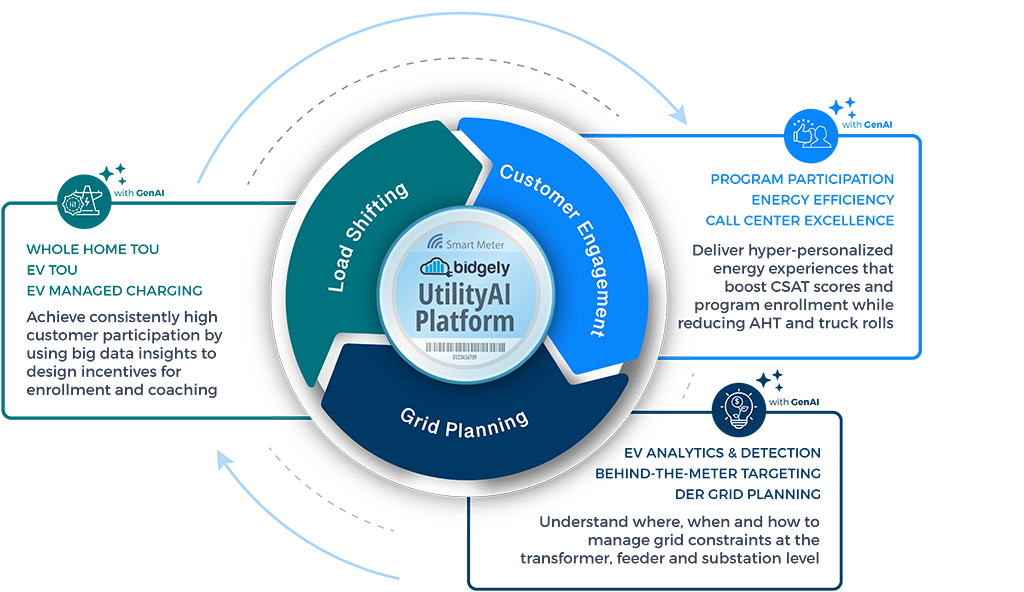
Just as Amazon’s flywheel inspired a retail evolution, the energy space is now poised for its own transformative flywheel transition.
If you would like to learn more about how an integrated approach to customer engagement, grid planning and load management can accelerate growth and resilience in your organization, reach out to our team to schedule a live demo.
I’m thrilled to share some exciting news: Bidgely has acquired Grid4C, a leader in AI-based predictive analytics for the energy industry.
This acquisition marks a significant moment for Bidgely, solidifying our leadership position in AI-powered energy intelligence. Combining our industry-leading AI with strategic acquisitions like Grid4C allows us to deliver unprecedented innovation and value to the energy sector.
Grid4C is a recognized leader in the predictive energy analytics space, with close to 10 patents to its name, and has developed novel solutions around fault detection & diagnostics of home appliances and grid assets, as well as load and DER forecasting.
The company, backed by strategic investors such as Alectra Utilities and Engie, has gained traction among North American, APAC, and European utilities through these very relevant offerings that help solve the industry’s big challenges.
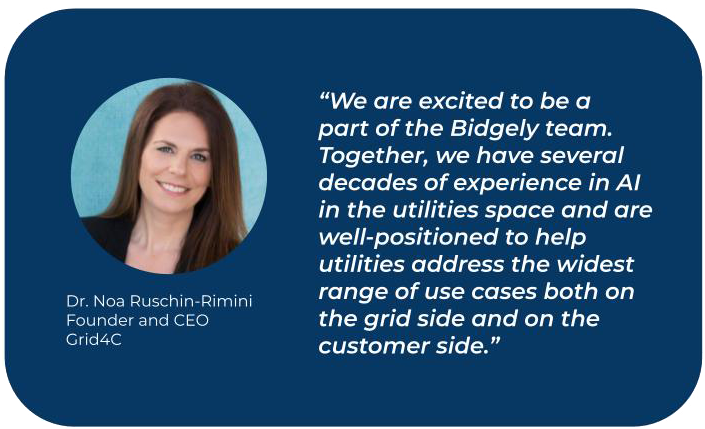
I’m also pleased to welcome Dr. Noa Rimini, Founder and CEO of Grid4C and a PhD in artificial intelligence and machine learning as well as the Grid4C team to Bidgely. We look forward to their contributions to our UtilityAI platform of customer- and grid-facing solutions. Dr. Rimini is an engineering and data science leader, which will only further supercharge our data science leadership team
and the value outcomes we deliver to our utility partners as an Energy Intelligence leader.
Grid4C’s solutions are an excellent complement to our existing platform. This acquisition will strengthen the core capabilities of Bidgely’s UtilityAI™ Platform and expand support for new use cases.
Specifically, Grid4C’s fault detection and short-term load forecasting solutions bring powerful enhancements:
This acquisition signals a new growth era for Bidgely. For over a decade, we have been focused on developing our own data science and solutions, and have built organically built out a client portfolio encompassing dozens of utilities around the world and tens of millions of utility customers served.
Now, with this first strategic acquisition, we’re accelerating that trajectory. We are well-positioned as a growing partner for the future, to help utilities innovate and tap into the power of AI to solve their biggest grid and customer engagement challenges and to help drive the clean energy transition.
I had the pleasure of sharing the mic with NV Energy’s Director of Integrated Energy Solutions Adam Grant on The Edison Electric Institute’s Electric Perspectives podcast. During the broadcast, Adam and I shared our thoughts about how AI-powered technology is advancing electric transportation programs.
Adam kicked off the discussion by describing what led NV Energy to look to AI-driven EV solutions.
“We’ve been using Bidgely’s UtilityAI platform as our overall tool for our customer solutions since 2017, starting with customer experience and energy efficiency and now moving into EVs,” Adam explained. “We used Bidgely’s behind-the-meter intelligence—technology that analyzes energy usage patterns at the household level—to identify customers who had high usage load and were also charging their electric vehicles on peak. With Bidgely, we were able to detect not only the type of charger being used, but also when it was being used – which empowered us to precisely target EV owners with peak charging behaviors.”
Bidgely’s EV Solution not only detects electric vehicles and helps utilities understand their load patterns, but we also provide a data-driven approach to better engage those customers to help them optimize their charging habits and reduce their bill.
“As utilities, we need to recognize that every customer has their own unique charging habits,” he went on to say. “Some charge as soon as they get home. Others charge overnight. And some charge at different times based on convenience. And when the customer charges is just as important to grid management as the charging itself. Our goal was to use this deeper understanding of EV behaviors to inform new EV managed charging programs we’ve proposed to our commission, and really put forth a program for customers that effectively shifts the charging load.”
The deeper understanding of EV behaviors that Adam mentioned is the foundation of Bidgely’s EV Solution. We believe identifying electric vehicles on the grid and their charging patterns is not just AI for the sake of AI. This intelligence has the potential to make a tangible impact on the system itself. When a utility is able to really understand who’s charging and how they’re charging, it becomes possible to take informed action to support grid modernization and grid stability and scale it rapidly.
Scalability is crucial. There is no silver bullet in the realm of EV management or EV customer engagement. That’s why Bidgely’s EV solution is designed to engage the full range of customers with different ways they can participate — serving the full EV owner customer base both today, as well as when that population grows to hundreds of thousands of customers.
According to the International Energy Association, new electric car registrations totalled 1.4 million in 2023, increasing by more than 40% compared to 2022. JD Power expects EV sales to reach 36% of the total U.S. retail market by 2030 and 58% by 2035. For a mid-sized utility, this could mean managing thousands of new distributed energy resources within just a few years.
As Adam said, “When it’s time to make the leap from our trial program to the thousands of customers who will be participating in the future, we recognize that it’s going to take significantly more EV detection, targeting and personalized customer outreach to engage the greatest number of customers who are best-positioned to realize benefit for themselves and the grid.”


NV Energy is leading the way in deploying AI and other technology solutions to hyper-personalize and target its programs, including its approach to rate design.
Given Nevada’s primary industries, granular household appliance-level data is incredibly important to informing new tariffs. As Adam described, Las Vegas is different from other major metropolitan areas.
“Beyond the electrification challenges which every large city is beginning to face, the casino industry makes us a 24-hour town,” he said. “Everyone in our community doesn’t work 9 to 5, or even, 6 to 2. A large number of our customers work graveyard and overnight. So there are people who are home during the day when the time of use doesn’t necessarily work for them. So that’s another challenge here in Nevada, is to have the behind-the-meter insights to create a mix of opportunities for our customers that are unique to the schedules they have.”
NV Energy’s strategy of layering different types of offerings encourages participation of the broadest possible range of customers, whether it is through active managed charging, or a time of use rate that provides a way to save money on their own schedule. Not every customer is going to want the full automation of managed charging, but they may be enticed by a program that allows them to save money by scheduling their car’s charging during a reduced TOU rate period.
It’s important to recognize that there is not one optimal end-all solution. Instead, we have to be responsive to the fact that the solutions we offer need to align with customers’ varied charging habits.
“Our approach is multifaceted,” Adam emphasized. “It has behavioral components. It’s got the tariff. It’s got the technology components. So it really is a full strategy to make sure that we have the ability to serve as many customers as possible.”
NV Energy’s approach to EV management will serve them well. They’re leveraging their behind-the-meter intelligence to implement a comprehensive approach to manage their EV load. Even if you’re not yet seeing the stress of EV adoption in your territory, you will soon, and it will be exponential in its growth. Utilities can’t fail to take steps now, assuming it will be possible to deploy an effective large scale EV program after adoption reaches scale.
Across the country, we are seeing a number of exciting EV program trials. But we can’t stay in trial mode much longer. We have to expand quickly to bigger and better programs and learn from these experiences.
“We know that electric vehicle load is coming. We know potential building electrification load is coming. And we know that, especially in our territory in the desert southwest, extreme heat is a reality. I think we had 32 straight days over 110 degrees last summer. So having that extra load from EV chargers and buildings on top of cooling load is significant,” Adam said.
“We need to find the most effective ways to shift EV load to periods when we have excess renewable energy in our system so that we don’t have to build that next power plant. Sure, we’re going to have to expand our generation capacity over the long haul. But we’re designing our EV program to allow us to delay that step. It’s much less expensive to put these programs in place – which of course also allows us to provide more price stability for customers.”
At the end of the day, commissions will play a very active role in determining whether to continue, expand or refine EV program investments. Across regulated territories, we’re seeing three key aspects to success.
Customer Engagement and Satisfaction – High performing EV programs will enhance, rather than detract from, the utility-customer relationship. Measuring customer satisfaction with the program and their understanding of how it relates to their energy bill will be a key metric as the utility company becomes the new gas station.
Load Shifting – We need to measure the ability of each electric vehicle to contribute to a kW shift off-of-peak. Doing so requires measuring the before and after – i.e. normally this customer would have contributed Y kW on an average demand day, but now we’re able to reduce that, or shift that to X kW.
This is particularly important when bringing incentive dollars into the mix. We need to begin to equate incentive ROI to the relative value a customer provides to the system. In other words, if a customer is already charging their vehicle at midnight, it does not make sense to offer them an incentive. Rather, we have to intelligently target the right customers -– those who are on constrained feeders or charging on-peak — and shift the metric for success from the number of vehicles enrolled in an incentive-driven program to kW reduction per participant, and begin compensating customers not for their participation but rather for their kWs.
Potential Savings – If you’re filing an IRP or a transportation electrification plan, what can you actually count on in terms of economic benefit and lower infrastructure impact? What can a grid operator rely on? It’s important to quantify the amount of grid support an EV program has the potential to deliver.
Highlighting that customer engagement is the foundational metric, Adam said, “I think that the main thing that we are learning is that education is the most important thing up front — really defining what the parameters are for the customer, so they understand the benefits that not only they’re getting for themselves, but also to the grid and price stability, because we don’t have to either buy power during the highest usage times, or build that next power plant or that peaker unit. Because, as we all know, customers are going to do what benefits them individually for the most part. So showing them their personal benefit is a really good start, and then layering onto that the benefits it has for the community and for everyone else could be really beneficial overall.”
The next big step is integrating that customer engagement into grid side planning and building full non wires alternatives programs.
Managing EV load is an essential part of an AI-driven, holistic approach to creating the resilient grid of the future.
Learn more by listening to the full EEI Electric Perspectives Podcast: AI-Powered Solutions for Transportation Electrification podcast.

Ai is still evolving and may not be perfect. Always verify important details for accuracy.